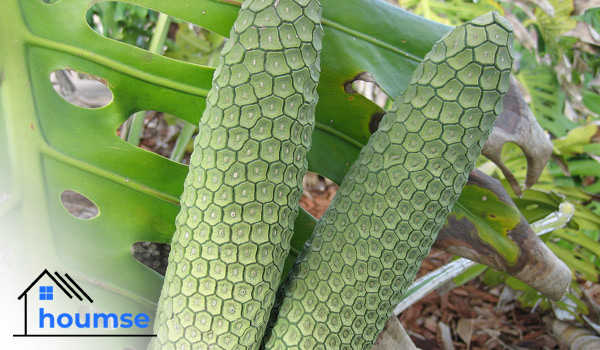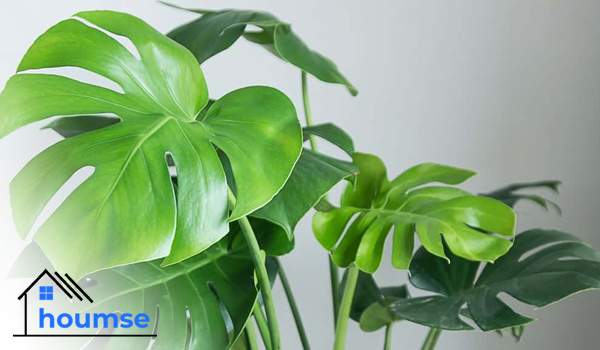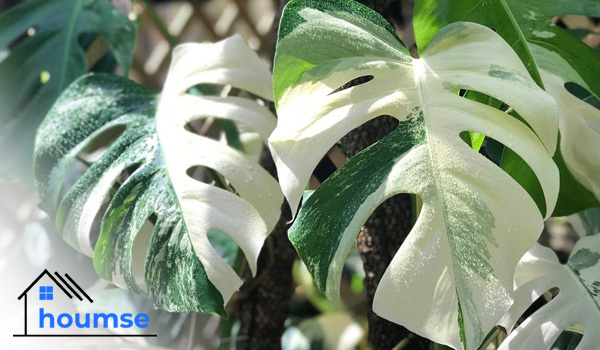Monstera Deliciosa: How to Care for Monstera Plant?

Monstera deliciosa was a very popular houseplant during the 1960s and 1970s, and now that the urban jungle trend is popular, it is back. The monstera plant leaves have the power to infuse the jungle air to any corner and goes well with any decoration style. It is also a resistant and undemanding plant, suitable even for beginners.
There is no self-respecting plant lady or gentleman who does not have (or does not want to have) this plant in her/his house. If that is you, scroll through to find everything you need about monstera plant care indoors.
Monstera Deliciosa, an Overview
Monstera deliciosa was first described in 1849 by Danish botanist Frederik Michael Liebmann during one of his travels through Mexico. monstera plant is native to the tropical jungles of South America where it grows in the undergrowth, the vegetation below the treetops with plenty of shade and a mild temperature.
‘Monstera’ is a Latin term to describe something monstrous or out of the ordinary, referring to its peculiar leaves with cuts and holes. And the word ‘deliciosa’ (meaning delicious) is a hint at its edible fruit that appear in the plant’s natural habitat or under the same climatic conditions. The fruit has a sweet taste similar to that of pineapple and mango.
Monstera’s Leaves
There are several theories that seek to explain the cuts and holes in the monstera deliciosa leaves. One of them is the tropical climate with its strong winds and rains. It is believed that an uncut leaf could break more easily in heavy rain. Instead, the holes allow wind and rainwater to pass through, protecting the integrity of the monstera plant.
Another theory points to a plant strategy to make better use of the scarce light it receives in the undergrowth and thus optimize its photosynthesis process. In fact, not all Monstera leaves have holes: the young and small leaves are usually complete. As the plant ages, they develop the holes.
Monstera’s Size
The Monstera deliciosa can reach 65 feet in height in its natural habitat, with huge leaves up to 30 x 35 inches. However, there is no need to worry about the size of monstera plant care indoors. Even if it receives all the love it deserves, it will not grow taller than 6.5 feet.
Still, you need to find a suitable spot for a successful monstera deliciosa care. So, no windowsills or shelves!
Flower and Fruit
The monstera plant flower appears when it is more than three years old. It is cream-colored and measures about 8 inches. The fruit is formed inside, with an appearance reminiscent of a corn cob. It is important to consume it when it is ripe, otherwise, its high content of oxalic acid can be toxic.
Both the flower and the fruit are produced only in their natural habitat, or in a space that faithfully offers them. Something you may want to keep in mind for monstera care.

Is Monstera Toxic to Cats and Dogs?
Monstera deliciosa is toxic to dogs, cats, and any other pets. If your four-legged friends like to nibble on your plants, be careful to place it out of their reach. It is also toxic for people, so the same applies if you have small children or receive visits with children.
How to Care for Monstera
Despite being originally an outdoor plant, the Monstera adapts perfectly to bright. If its size allows it, you can even have it inside the house during the months of extreme cold or heat and allow it to enjoy the outside the rest of the year.
Overall, this is no complicated plant, so follow these monstera deliciosa care tips and you will enjoy it for years, even decades!
Watering
Water moderately approximately every 7 days in summer and every 15 days in winter. Remember that this is just a guideline, the frequency of watering in monstera care also depends on the temperature, humidity, and the soil. So, adjust the watering according to the plant’s conditions.
To avoid root rot, check the top 2 inches of the potting mix. If it felt wet, do not water yet and wait until it is dried out.
Monstera Plant Light
Monstera hates direct sunlight but loves bright environments. To provide the ideal indirect light, place your plant in a room with plenty of natural light, but make sure it never receives direct sunlight, as this could burn its leaves. This is especially important if the plant is on a patio or deck.
It can also adapt to more shady rooms, but if the monstera plant light is insufficient, the leaves may not develop their characteristic holes.

Temperature and Humidity
Your Monstera will be happy in temperatures between 65-80ºF. The growth will be slow below 65ºF and stop altogether below 50ºF. In monstera plant care outdoors (in climates with cold winters), remember that it does not tolerate frost.
Medium to high humidity is perfect for monstera deliciosa care. It is recommended to mist the plant if the environment is dry, especially during cold months when you turn on the heating system.
Monstera Plant Soil and Fertilizer
The Monstera deliciosa is not a very demanding plant in this sense. You can practically use any peat-based soil and add a bit of perlite for better drainage. The most important thing in monstera plant care regarding the potting mix is that it drains well to avoid soggy soil.
Use a liquid fertilizer (diluted with water used for irrigation) about every 4-5 weeks during spring and summer. Follow the directions on the package to calculate how much fertilizer to add and keep an eye on the leaves for days and weeks to come as excess fertilizer can burn leaves.
Maintaining (Pruning and Cleaning)
If your Monstera is out of control and you need to prune it for propagation or simply keep it compact, do it in the spring. Cut the stems below a node and place them in water to develop roots. Remove any leaves that look sickly too. In addition to an occasional, you will need regular cleaning in the monstera care.
The large leaves tend to accumulate dust, so it is important to clean them (using a clean, wet cloth) whenever necessary so that they can breathe and absorb moisture from the environment.
Also, every 6-8 weeks, give your monstera plant an extra dose of love by simulating rain like it is in the jungle. How? Place the pot in the bathtub and spray the plant with the showerhead. Soak the soil and water each leaf to remove the dust as well. Once it has drained well and the leaves are no longer dripping, place it where it was.
Potting and Re-potting
How to care for monstera when it outgrows the pot? Transplant the plant into a larger pot every two years, preferably in the spring. When you do, also take the opportunity to remove the roots and leaves that are in poor condition.

Common Pest and Problems
mealybugs, aphids, thrips, scale, and spider mites are among common pests that can cause problems for your plant. If you found any of them on the foliage, spray the plant with a direct water stream. You can also wash the leaves with insecticidal soap. As you can guess, using the cleaning tips discussed earlier on monstera deliciosa care, you will not be bothered by pests much.
Now, how to care for monstera when it shows signs of disease? For this, you need to know the cause of such common problems.
- Yellow Leaves: It is a common problem and occurs due to excess moisture. You may have over-watered it or left it standing in water in the saucer.
- Brown Leaves: Brown leaves are burnt leaves due to excessive direct sun.
- Dropping Leaves: This mostly indicates a lack of moisture. Consider more watering or a potting mix with better moisture retention in monstera care.
Popular Monstera Varieties
There are more than 90 varieties of monstera plants. Being of the same family, the care they require is usually identical. So, if you have a deliciosa in your collection, you may also want to add (one of) these varieties to your collection:
- Monstera Deliciosa Variegata: With eye-catching foliage, this deliciosa (there are also borsigiana versions) displays leaves with white brushstrokes, even completely white leaves.
- Monstera Adansonii (Swiss Cheese plant): this is a climbing variety with small, perforated leaves. You will see it growing around a stake, climbing a wall, or with its stems falling from a hanging pot. It has consistent leaves with surfaces occupied by rather small holes.
- Monstera Obliqua: As a true unicorn in the plant world, it is practically impossible to find. And if you find it in a store, it is most likely a Monstera adansonii and not an obliqua, a hybrid variety at best. This particular monstera plant has very thin leaves with huge holes that occupy almost the entire leaf.
- Monstera Borsigiana: This species is very similar to monstera deliciosa (they are often confused). In fact, the vast majority of monsteras currently sold as deliciosa are actually borsigiana. However, it is a smaller size plant that has smooth stems with smaller leaves and fewer holes.

Monstera Plant Propagation
There are several methods to propagate a monstera plant:
Using Seeds
First, purchase monstera deliciosa seeds online and prepare to embark on the exciting journey of sowing and watching them grow!
To germinate the seeds (after planting them like any other plant seeds), place the pot in a bright and temperate place, and provide ideal humidity. The young leaves will appear in about a month.
Using Cuttings
Inspect it and find those stems that give it the messiest look. Look closely, do they have aerial roots? Brilliant! Those stems are the perfect candidates for monstera plant propagation by cutting.
Locate the base of the stem -from where the leaves are born- and make a clean cut about an inch below with pruning shears. Put the cutting and its roots in a container with water.
Refresh the water every week and soon you will notice small white roots that are born from the aerial roots. When they measure about an inch, transplant the cutting into a pot. Propagation monstera deliciosa mission accomplished!
- In this post:
- Monstera Deliciosa, an Overview
- How to Care for Monstera
- Popular Monstera Varieties
- Monstera Plant Propagation



